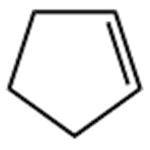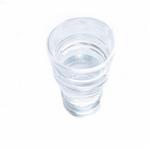- Cyclopentene
-

- $100.00 / 1KG
-
2023-12-26
- CAS:142-29-0
- Min. Order: 1KG
- Purity: 99%
- Supply Ability: g-kg-tons, free sample is available
- Cyclopentene
-

- $0.00 / 25KG
-
2023-08-29
- CAS:142-29-0
- Min. Order: 1KG
- Purity: 99%
- Supply Ability: 50000KG/month
- Cyclopentene
-

- $48.00 / 1KG
-
2023-05-04
- CAS:142-29-0
- Min. Order: 1KG
- Purity: 99%
- Supply Ability: 200tons
|
| | Cyclopentene Basic information |
| | Cyclopentene Chemical Properties |
| Melting point | −135 °C(lit.) | | Boiling point | 44-46 °C(lit.) | | density | 0.771 g/mL at 25 °C(lit.) | | vapor pressure | 20.89 psi ( 55 °C) | | refractive index | n20/D 1.421(lit.) | | Fp | <−30 °F | | storage temp. | 0-6°C | | solubility | water: soluble0.535g/L at 25°C | | form | Liquid | | Specific Gravity | 0.771 | | color | Colorless | | Water Solubility | immiscible | | Sensitive | Air Sensitive | | BRN | 635707 | | Henry's Law Constant | 6.3 x 10-2 atm?m3/mol at 25 °C (Hine and Mookerjee, 1975) | | Stability: | Stable. Highly flammable. Incompatible with strong oxidizing agents. Store cold. | | InChIKey | LPIQUOYDBNQMRZ-UHFFFAOYSA-N | | LogP | 2.47 at 25℃ | | CAS DataBase Reference | 142-29-0(CAS DataBase Reference) | | NIST Chemistry Reference | Cyclopentene(142-29-0) | | EPA Substance Registry System | Cyclopentene (142-29-0) |
| | Cyclopentene Usage And Synthesis |
| Chemical Properties | Cyclopentene is a highly flammable liquid with a low flash
point. It reacts readily with oxidizing agents. | | Physical properties | Clear, colorless, watery, very flammable liquid with a characteristic sweet, petroleum-like odor. | | Uses | Cyclopentene is a cycloalkene that is cyclopentane having one endocyclic double bond. Vapors heavier than air. Inhalation of high concentrations may be narcotic. Used to make rubber and plastics.
Neopentyl phosphine ligand catalyzed Heck coupling of cyclopentene has been reported. Mechanism of reaction of ground state oxygen atom with cyclopentene has been investigated. Homopolymerization of cyclopentene has been reported. Photocatalytic oxidation of cyclopentene over various titanium(IV) oxide catalyst has been reported.
Cyclopentene was used to investigate the [2+2] cycloaddition of diamond (001) surfaces with alkene. | | Uses | Cyclopentene is used in organic synthesis for cross-linking resin. It is used as an intermediate in Industries such as Agrochemical, Dyestuff, Pharmaceutical, syntheses material, Chemical. It is used as a monomer for synthesis of plastics and rubber. It is also used for the synthesis of various chemicals, such as 1,1,2-Trimethylcyclohexane. | | Preparation | Cyclopentene is synthesized by selective hydrogenation of cyclopentadiene or by dehydration of cyclopentanol. It is produced industrially in large amounts by steam cracking of naphtha. Cyclopentene is present in coal tar, cigarette smoke, and automobile emissions. | | Definition | ChEBI: Cyclopentene is a cycloalkene that is cyclopentane having one endocyclic double bond. | | General Description | Cyclopentene appears as a colorless liquid. Less dense than water and insoluble in water. Flash point below 0°F. Vapors heavier than air. Inhalation of high concentrations may be narcotic. Used to make rubber and plastics. | | Air & Water Reactions | Highly flammable. Insoluble in water. | | Reactivity Profile | Cyclopentene may react vigorously with strong oxidizing agents. May react exothermically with reducing agents to release hydrogen gas. In the presence of various catalysts (such as acids) or initiators, may undergo exothermic addition polymerization reactions. | | Health Hazard | May be harmful by inhalation, ingestion, or skin absorption. May cause eye and skin irritation. | | Fire Hazard | Special Hazards of Combustion Products: Vapor may travel considerable distance to a source of ignition and flashback. Explosion may occur under fire condition. | | Safety Profile | Moderately toxic by
ingestion and skin contact. A very
dangerous fire hazard when exposed to
flame or heat; can react with oxidning
materials. Keep away from heat and open
flame. To fight fire, use foam, CO2, dry
chemical. | | Source | Schauer et al. (2001) measured organic compound emission rates for volatile organic
compounds, gas-phase semi-volatile organic compounds, and particle-phase organic compounds
from the residential (fireplace) combustion of pine, oak, and eucalyptus. The gas-phase emission
rate of cyclopentene was 7.8 mg/kg of pine burned. Emission rates of cyclopentene were not
measured during the combustion of oak and eucalyptus.
California Phase II reformulated gasoline contained cyclopentene at a concentration of 1,120
mg/kg. Gas-phase tailpipe emission rates from gasoline-powered automobiles with and without
catalytic converters were 480 and 31,700 μg/km, respectively (Schauer et al., 2002).
Given that cyclopentene is prepared from cyclohepentanol, the latter may be present as an
impurity. | | Environmental fate | Biological. Cyclopentene may be oxidized by microbes to cyclopentanol, which may oxidize to
cyclopentanone (Dugan, 1972).
Photolytic. The following rate constants were reported for the reaction of cyclopentene with OH
radicals in the atmosphere: 6.39 x 10-11 cm3/molecule?sec (Atkinson et al., 1983), 4.99 x 10-11
cm3/molecule?sec at 298 K (Rogers, 1989), 4.0 x 10-10 cm3/molecule?sec (Atkinson, 1990) and
6.70 x 10-11 cm3/molecule?sec (Sablji? and Güsten, 1990); with ozone in the atmosphere: 8.13 x
10-16 at 298 K (Japar et al., 1974) and 9.69 x 10-16 cm3/molecule?sec at 294 K (Adeniji et al.,
1981); with NO3 in the atmosphere: 4.6 x 10-13 cm3/molecule?sec at 298 K (Atkinson, 1990) and
5.81 x 10-13 cm3/molecule?sec at 298 K (Sablji? and Güsten, 1990).
Chemical/Physical. Gaseous products formed from the reaction of cyclopentene with ozone
were (% yield): formic acid, carbon monoxide, carbon dioxide, ethylene ,
formaldehyde, and butanal. Particulate products identified include succinic acid,
glutaraldehyde, 5-oxopentanoic acid, and glutaric acid (Hatakeyama et al., 1987).
At elevated temperatures, rupture of the C-C bond occurs forming molecular hydrogen and
cyclopentadiene (95% yield) as the principal products (Rice and Murphy, 1942). | | Purification Methods | Free cyclopentene from hydroperoxide by refluxing with cupric stearate. Fractionally distil it from Na. It can be chromatographed on a Dowex 710-Chromosorb W GLC column. Methods for cyclohexene should be applicable here. Also, it has been washed with 1M NaOH solution followed by water. It was dried over anhydrous Na2SO4, distilled over powdered NaOH under nitrogen, and passed through neutral alumina before use [Woon et al. J Am Chem Soc 108 7990 1986]. It was distilled in a dry nitrogen atmosphere from powdered fused NaOH through a Vigreux column (p 11), and then passed through activated neutral alumina before use [Wong et al. J Am Chem Soc 109 3428 1987]. [Beilstein 5 IV 209.] | | Toxicity evaluation | Acute Toxicity. The oral LD50 in the rat is
1656 mL/kg, and the dermal LD50 in the rabbit is
1231 mL/kg. Inhalation of the concentrated vapor was lethal
to rats in 5min, and a 4 h exposure to 16,000 ppm was lethal
to four of six rats.
Chronic and Subchronic Toxicity. Chronic
exposure of rats to 112–1139 ppm for 12 weeks showed
no effects, whereas 8110 ppm for 6 h/day, 5 days/week for
3 weeks resulted in decreased body weight gains of female
rats.
Human Experience
General Information. Short-term exposure of
cyclopentene to humans revealed a tolerable level of only
10–15 ppm. |
| | Cyclopentene Preparation Products And Raw materials |
|